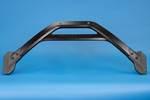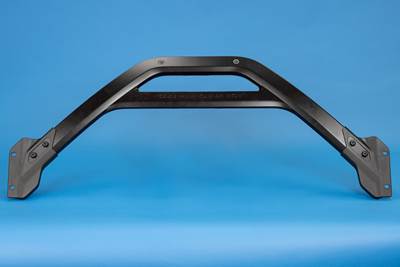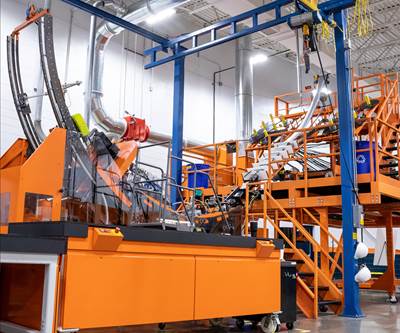Pultruded CFRP chassis enables 36% payload increase for specialized commercial vehicles
CarbonTT’s quadraxial NCF composite chassis adds 185-kilogram capacity to Borco Höhns’ 3.5-ton Fiat Ducato market vehicle.
CarbonTT’s carbon fiber-reinforced polymer (CFRP) chassis is integrated into the Borco Höhns Fiat Ducato. The advanced composite design reduces the chassis weight by 185 kilograms, enhancing payload capacity and operational efficiency. Source | Borco Höhns
In the evolving landscape of urban logistics and mobile commerce, the demand for specialized, lightweight commercial vehicles has surged. Driven by rapid urbanization, the boom of on-demand services and industries spanning last-mile delivery, food distribution, mobile healthcare and specialized maintenance are increasingly relying on compact, adaptable vehicles. These vehicles enable efficient, flexible service in densely populated areas and restricted zones where larger vehicles face operational and regulatory barriers.
A key constraint in these sectors is the strict 3.5-metric ton (MT) weight threshold — a regulation pivotal in most European and many global markets that separates light commercial vehicles (LCVs) from heavy goods vehicles (HGVs). Crossing this limit typically incurs additional costs (such as tolls), requires specialized driver licensing and subjects operators to more intensive regulatory oversight. For companies striving to optimize logistics while minimizing expenses, staying within the 3.5-MT classification is essential.
In 2023, specialized retail vehicle seller, Borco Höhns (Rothenburg, Germany), set out to enhance the commercial efficiency of its 3.5-MT max weight vehicles by minimizing the base vehicle weight. To address this, Borco Höhns collaborated with Carbon Truck & Trailer GmbH (CarbonTT, Buxtehude, Germany), a company specialized in the development and automated production of structural composites, to develop a carbon fiber-reinforced polymer (CFRP) chassis for its Fiat Ducato-based retail vehicle, replacing the steel version.
Following 18 months of development, the resulting CFRP chassis led to a 185-kilogram weight reduction for the sub-3.5 MT Borco Höhns Fiat Ducato while maintaining the necessary robustness for specialized retail vehicle applications. This enhances the 510-kilogram payload of the steel chassis version by 36%, translating to a proportional boost in revenue potential for each load transported.
“By reducing vehicle weight, we give customers more flexibility — whether that’s carrying additional goods, adding equipment or staying under weight restrictions that affect licensing and road access,” explains Gerret Kalkoffen, CEO of CarbonTT. “This could be a game changer for the industry.”
Design challenges and material selection
Finite element analysis (FEA) simulation of a chassis mounting bracket under load. Stress concentrations are visualized to optimize the composite design. Source | CarbonTT
CarbonTT designed the CFRP chassis, which included an optimized fiber layup, resin chemistry and development of a novel pultrusion manufacturing process. “Pultrusion manufacturing necessitates a uniform profile thickness,” explains Kalkoffen. “When loads are unevenly distributed — such as in centrally located interfaces versus vehicle overhangs — it is challenging to find an optimum of load, weight and cost. Looking at global loads, fibers costs and production speeds, we did not want to exceed 3 millimeters. This was only possible with our patented interfaces that transfer and translate loads from steel to composite.”
The chassis design uses a symmetric quadraxial noncrimp fabric (NCF) architecture made with Zoltek (St. Louis, Mo., U.S.) 50K tow PX35 carbon fiber, showcasing 0°, +45°, -45° and 90° fiber orientations. “The stitching characteristics are crucial for determining fabric shapeability,” notes Kalkoffen. “We carefully define the stitch strength and yarn type to balance stiffness for pultrusion processing against the fabric’s ability to conform to complex profiles. This approach means precise fiber control during manufacturing while maintaining the material’s ability to handle both longitudinal and torsional loads.”
Custom pultrusion technology, methodology
At the heart of CarbonTT’s solution is a bespoke pultrusion manufacturing technology. Built on a Pultrex/KraussMaffei (Manningtree, U.K.) pultrusion line, the system features custom-designed fiber racks, shaping units, grippers, an automated tension control system, saw and an injection box. Based on a Covestro (Leverkusen, Germany) polyurethane system, CarbonTT formulated a specialized resin that incorporates various functional additives to facilitate smooth processing through the pultrusion process. These additives regulate viscosity and cure kinetics to achieve complete fiber wet-out within the injection stage. Additionally, the inclusion of UV stabilizers and heat-resistant compounds in the resin provides long-term durability for the chassis in service.
The custom-designed pultrusion line developed by CarbonTT for manufacturing CFRP chassis beams ensures precise fiber orientation and seamless resin infusion. Source | CarbonTT
“Our fiber guidance system represents a significant advancement in pultrusion technology,” Kalkoffen says. “Traditional pultrusion struggles with complex fiber architectures. Over several years, and with countless struggles, we have developed a unique control system using multiple sensors to maintain precise fiber feed positioning relative to the tooling. These sensors continuously monitor fiber position and orientation, feeding data to the automated tension control system that makes real-time adjustments to prevent fiber misalignment, wrinkling or the formation of cavities that could compromise structural integrity.” This technology enables CarbonTT to produce profiles with complex shapes at high production speeds without wrinkles, which is key to achieving good material properties and minimizing the cost of fibers per application.
CarbonTT also developed proprietary technology for generating and controlling pressure gradients within the injection zone. “Generating adequate pressure in the injection system requires precise control of multiple variables,” notes Kalkoffen. “Because of the continuous nature of pultrusion, the injection box is open on two sides — so if you need a certain pressure for the resin to reach the central fibers, you can’t just increase the pressure on your metering machine. We had to develop the resin to penetrate and cure with this challenging scenario.”
Material testing, chassis validation
Material validation followed a rigorous protocol developed to address both performance and long-term durability requirements. Initial testing began with coupons placed in environmental chambers specially configured to simulate extreme service conditions. Test specimens underwent temperature cycling from -40°C to +80°C while exposed to salt spray environments, with specific attention paid to material interfaces and bonded joints. Each cycle included controlled humidity variation to evaluate moisture resistance and potential degradation mechanisms.
Full-scale chassis testing employed sophisticated hydropulse equipment to simulate real-world loading conditions. Composite-to-metallic interfaces received particular attention during this stage with test procedures to evaluate adhesive bonding and mechanical fastening methods. “We conducted fatigue testing applying 500,000 load cycles simulating payload operation, followed by 200,000 cycles at 20% overload, equivalent to approximately 160,000 kilometers of service,” details Kalkoffen. “The composite chassis showed no measurable fatigue or degradation through these accelerated life tests. We then applied the hydropulse’s maximum force but could not break the chassis.”
Interface validation test setup for composite-to-metal connections in the CFRP chassis. Load measurements in multiple directions ensure robust joint performance. Source | CarbonTT
Vehicle-level dynamics validation followed. This involved specialized tests using a fully instrumented vehicle and test track to gather performance data on stability, including emergency maneuver scenarios, which verified the composite chassis’ impact. Each phase went through certification processes with TÜV Rhineland (Cologne), Germany’s vehicle certification authority, ensuring compliance with industry standards.
Design and market impact
The lightweight composite chassis also offers significant benefits from an operational standpoint. “Lower mass means a higher payload in one direction and a lower vehicle weight in the other,” says Kalkoffen. “This has a positive effect on energy consumption — whether using traditional fuel or electricity — and thus reduces the CO2 emissions per delivered good. Lower energy consumption also means a greater range, allowing operators to optimize routes. For fleet owners, a payload increase of 10-20% may mean reducing your fleet size and required drivers by that same amount. This has a massive impact on the total cost of ownership.”
The design of CarbonTT’s chassis is unconventional. While a traditional chassis consists of a ladder frame with two long beams and multiple cross beams for torsional stiffness, the CFRP chassis only features long carbon fiber beams, which manage to bear the torsional loads by merely stiffening any standard floor plate. “The absence of cross-members creates accessible space for additional equipment installation without compromising structural integrity,” explains Kalkoffen. “This space can be used to safely integrate large traction batteries or water tanks in recreational vehicles.”
This completed CFRP beam component showcases the quadraxial fabric architecture and optimized stiffness-to-weight ratio achieved through CarbonTT’s pultrusion process. Source | CarbonTT
CarbonTT has also considered repair methods for the composite chassis in the event of damage to ensure the Fiat Ducatos don’t reach end of life (EOL) prematurely. “Our approach includes methods for assessing damage, specifying repair mechanisms and ensuring that any necessary repairs can be performed by a local automotive shop,” explains Kalkoffen. “Although these repairs won’t create a Class A surface finish, we are confident that our solutions — involving patches applied to the rear of structures — will provide an acceptable aesthetic, safe and functional result, maintaining a low-cost and efficient repair process. This is critical, given these vehicles are vital to the businesses running them.”
Kalkoffen concedes that while composite production initially carries a higher carbon footprint than traditional steel manufacturing, CarbonTT’s life cycle analysis demonstrates an environmental impact payback within 1-2 years of regular service for the Borco Höhns Fiat Ducato. This rapid return stems primarily from reduced operational mass which reduces fuel consumption and lowers operational emissions throughout the vehicle’s service life.
Future potential
On the potential of the composite chassis for specialized, lightweight commercial vehicles, Kalkoffen says: “The pultrusion process is inherently scalable, but we’re not content with just scaling production. We’re actively investigating ways to improve sustainability across our entire manufacturing chain.” Current initiatives focus on further developing the resin system, such as exploring bio-based alternatives that maintain the critical processing and performance characteristics achieved with the current formulation.
“Collaboration with resin manufacturers in developing thermoplastic alternatives that could facilitate easier separation of resin and fiber at EOL, while maintaining the precise processing control required for the open-ended pultrusion system is also ongoing,” he continues. “While sustainability drives much of our development work, we must balance environmental improvements against the demanding performance requirements of commercial vehicle applications.”
The Borco Höhns Fiat Ducato is equipped with CarbonTT’s CFRP chassis during a dynamic performance test on a controlled track. The composite chassis significantly improves handling characteristics. Source | Borco Höhns
The company’s research program is also exploring recyclability options, prioritizing reuse over recycling where possible. Cost optimization also remains central to future development, with efforts focused on minimizing material waste, particularly in handling impregnated fibers. The current production system demonstrates impressive efficiency, with a single line capable of producing parts for up to 70,000 vehicles annually. “The company’s efforts in minimizing scrap rates at this high-volume, combined with a more sophisticated quality control system, will help offset the higher material environmental and financial costs associated with CFRP chassis components for this commercial vehicle application,” highlights Kalkoffen.
As urban delivery and mobile retail continue expanding, with increasing pressure for reduced emissions, lightweight solutions are poised to play a crucial role in the 3.5-MT vehicle industry’s evolution. The combination of significant payload increases enabling higher revenues with less trips, and advancing sustainability metrics, suggests that composite chassis technology may become increasingly prevalent in commercial vehicle applications in the future.
Related Content
PEEK vs. PEKK vs. PAEK and continuous compression molding
Suppliers of thermoplastics and carbon fiber chime in regarding PEEK vs. PEKK, and now PAEK, as well as in-situ consolidation — the supply chain for thermoplastic tape composites continues to evolve.
Read MorePlant tour: Albany Engineered Composites, Rochester, N.H., U.S.
Efficient, high-quality, well-controlled composites manufacturing at volume is the mantra for this 3D weaving specialist.
Read MoreCarbon fiber, bionic design achieve peak performance in race-ready production vehicle
Porsche worked with Action Composites to design and manufacture an innovative carbon fiber safety cage option to lightweight one of its series race vehicles, built in a one-shot compression molding process.
Read MoreTU Munich develops cuboidal conformable tanks using carbon fiber composites for increased hydrogen storage
Flat tank enabling standard platform for BEV and FCEV uses thermoplastic and thermoset composites, overwrapped skeleton design in pursuit of 25% more H2 storage.
Read MoreRead Next
Automotive chassis components lighten up with composites
Composite and hybrid components reduce mass, increase functionality on electric and conventional passenger vehicles.
Read MoreAll-recycled, needle-punched nonwoven CFRP slashes carbon footprint of Formula 2 seat
Dallara and Tenowo collaborate to produce a race-ready Formula 2 seat using recycled carbon fiber, reducing CO2 emissions by 97.5% compared to virgin materials.
Read MoreCurve in the road: First curved pultruded auto parts
Thomas Technik + Innovation KG’s radius pultrusion process unlocks new possibilities for the automotive market and beyond.
Read More





















